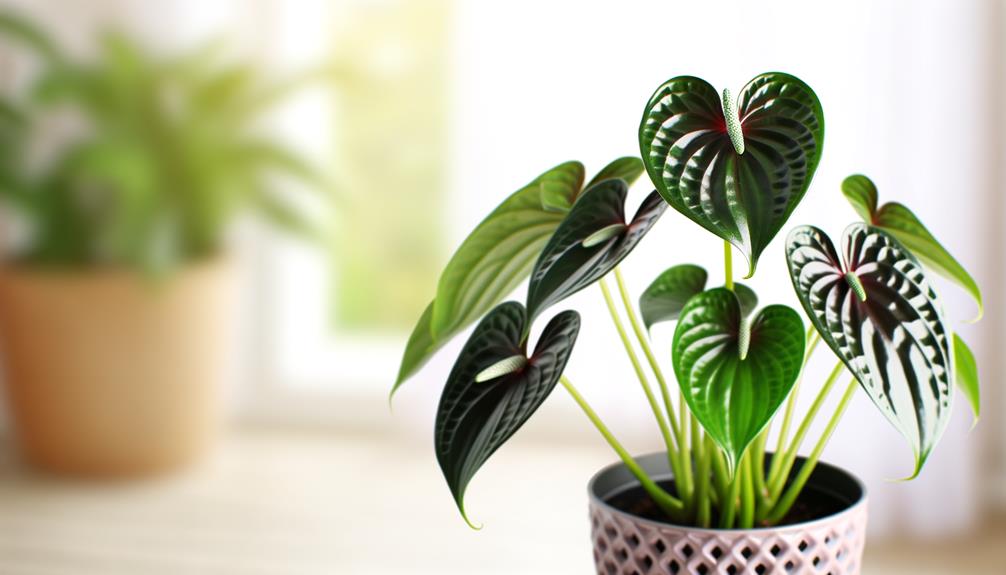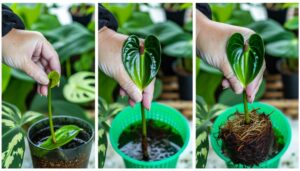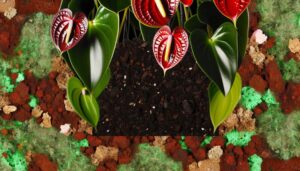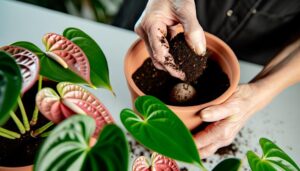Anthurium 'Ace of Spades' Care – A Complete How-To Guide
To care for Anthurium 'Ace of Spades', position it in bright, indirect light, avoiding direct sunlight to prevent leaf scorch. Maintain temperatures between 65°F-80°F and keep humidity at 60%-80%.
Water when the top inch of soil is dry using distilled or rainwater, and use a well-draining mix of orchid bark, perlite, and peat moss. Fertilize during growth phases and repot every 1-2 years.
Regularly check for pests like aphids and mealybugs, and prune dead leaves with sterilized tools. You'll soon discover more intricate details that guarantee your plant thrives.

Key Takeaways
- Place Anthurium 'Ace of Spades' in bright, indirect light and avoid direct sunlight to prevent leaf scorching.
- Maintain temperatures between 65°F and 80°F and ensure humidity levels between 60% and 80%.
- Water when the top inch of soil is dry, using distilled or rainwater, and ensure the pot has drainage holes.
- Use a well-draining soil mix with orchid bark, perlite, and peat moss, and repot every 1-2 years.
- Regularly inspect for pests and diseases, prune dead or yellowing leaves, and propagate through division or stem cuttings.
Light Requirements
To maximize growth, Anthurium 'Ace of Spades' requires bright, indirect light, avoiding direct sunlight which can scorch its leaves. Position your plant near an east or north-facing window, where it will receive diffused light. If placed in a south or west-facing window, use sheer curtains to filter the light.
Anthurium andraeanum, the botanical name, thrives in environments mimicking its native tropical habitat, where the canopy filters sunlight. Artificial lighting, such as fluorescent or LED grow lights, can supplement natural light, especially in low-light conditions. Maintain a light intensity of 10,000 to 20,000 lux for optimal photosynthesis.
Rotate the plant periodically to ensure even light distribution, preventing uneven growth and lopsided foliage. Proper lighting is essential for robust, healthy development.
Watering Needs
To maintain Anthurium 'Ace of Spades' (Anthurium crystallinum × Anthurium magnificum), water it when the top inch of soil feels dry, typically every 7-10 days.
Avoid overwatering by ensuring the pot has drainage holes and monitoring for symptoms like yellowing leaves or root rot.
Use distilled or rainwater to prevent mineral buildup, which can harm the plant.
Optimal Watering Frequency
Consistently monitor the soil moisture levels in your Anthurium 'Ace of Spades' to make sure it remains moderately moist but never waterlogged. Utilize a moisture meter or insert your finger an inch into the substrate to assess dampness.
Water the Anthurium clarinervium when the top layer feels dry to the touch, typically every 7-10 days. Employ distilled or rainwater to avoid mineral buildup, and water thoroughly until it drains from the pot's bottom. Confirm the potting mix, ideally a combination of peat, pine bark, and perlite, supports proper drainage.
Adjust the frequency in response to seasonal changes, increasing in warmer months and decreasing during cooler periods. Maintain consistent humidity around 60-80% to complement the plant's hydration requirements.
Identifying Overwatering Signs
Overwatering your Anthurium 'Ace of Spades' can lead to several detrimental signs, such as yellowing leaves, root decay, and a soft stem base. Keep an eye out for these indications to diagnose overwatering early.
The leaves of Anthurium crystallinum may become chlorotic, turning an unsightly yellow. Excessively damp soil promotes Phytophthora root decay, causing the roots to deteriorate.
Confirm you can identify these symptoms:
- Yellowing leaves: Indicates chlorosis due to too much water.
- Root decay: Roots appear brown and soft, losing their firmness.
- Soft stem base: Spongy, discolored stem base signals decay.
- Fungal growth: Mold or mildew on the soil surface.
- Leaf drop: Premature leaf shedding as the plant faces challenges.
Understanding these signs confirms your Anthurium 'Ace of Spades' remains vibrant.
Ideal Soil
You'll want to make sure the soil for Anthurium 'Ace of Spades' consists of a well-draining mix, typically combining orchid bark, perlite, and peat moss. This composition promotes proper drainage and aeration, preventing root rot.
Additionally, provide a nutrient-rich medium with balanced slow-release fertilizers to support best growth.
Proper Soil Composition
Why is it crucial to utilize a well-ventilated, quick-draining soil mix, such as a combination of orchid bark, perlite, and peat moss, for Anthurium 'Ace of Spades'? This epiphytic plant thrives in conditions that replicate its natural habitat, enabling roots to breathe and preventing root rot. A tailored soil mix enhances nutrient absorption and fosters robust growth.
To achieve the optimal composition, consider:
- Orchid Bark: Offers exceptional aeration and drainage.
- Perlite: Boosts soil aeration and prevents compaction.
- Peat Moss: Holds moisture while allowing excess water to drain.
- Charcoal: Absorbs impurities and maintains the soil's freshness.
- Coco Coir: Provides structure and retains moisture without becoming waterlogged.
Utilizing this blend guarantees your Anthurium 'Ace of Spades' thrives.
Drainage and Aeration
Proper drainage and aeration are critical for Anthurium 'Ace of Spades' to prevent waterlogging and promote healthy root development.
You should use a well-draining soil mix containing equal parts orchid bark, perlite, and peat moss. Orchid bark guarantees aeration, perlite enhances drainage, and peat moss retains moisture without becoming soggy.
Avoid compact soils which can cause root rot by suffocating the roots. A pH of 5.5-6.5 is ideal. You can add activated charcoal to the mix to improve drainage and reduce toxins.
Make sure your pot has drainage holes to allow excess water to escape. Regularly check the soil moisture; it should be damp but not waterlogged.
This careful balance promotes robust growth and prevents root diseases.
Nutrient Requirements
In addition to proper drainage and aeration, Anthurium 'Ace of Spades' requires a nutrient-rich soil mix to support its lush foliage and vibrant blooms. You should create a well-draining potting mix that mimics its natural epiphytic habitat.
Combine materials that will retain moisture without becoming waterlogged. A recommended mix includes:
- Orchid bark: Provides excellent aeration and mimics the plant's natural growing conditions.
- Perlite: Enhances drainage and prevents soil compaction.
- Peat moss: Retains moisture while adding organic matter.
- Activated charcoal: Purifies the soil and prevents root rot.
- Horticultural-grade coarse sand: Improves drainage and prevents water retention.
Mix these components in equal parts to guarantee your Anthurium 'Ace of Spades' thrives in an ideal growing medium.
Temperature Preferences
Anthurium 'Ace of Spades' thrives in temperatures between 65°F and 80°F, promoting ideal growth and vibrant foliage. Maintaining a stable temperature within this range is essential for Anthurium crystallinum.
Sudden temperature fluctuations can stress the plant, leading to poor leaf development and potential disease susceptibility. Place your Anthurium away from drafts, air conditioners, and heaters to avoid extreme temperature shifts.
During colder months, make sure the temperature doesn't drop below 60°F, as this can stunt growth and damage leaves. If you're growing the plant indoors, use a consistent heating source to maintain the best temperature.
Regularly monitor the temperature with a reliable thermometer to make sure that conditions remain favorable for the plant's health and development.
Humidity Levels
Maintaining optimal moisture levels, ideally between 60% and 80%, is just as crucial as temperature management for the thriving growth of Anthurium 'Ace of Spades'. You'll want to monitor and adjust moisture to replicate its native tropical environment. Use a hygrometer to measure levels accurately.
If necessary, employ methods to increase moisture.
- Use a humidifier: Position a humidifier near the plant.
- Pebble tray method: Place the pot on a tray filled with water and pebbles.
- Grouping plants: Group plants together to create a micro-moist environment.
- Misting: Gently mist the leaves daily, avoiding waterlogging the soil.
- Bathroom placement: Bathrooms often have higher moisture levels suitable for Anthurium.
Following these steps guarantees your Anthurium 'Ace of Spades' remains healthy and vibrant.
Fertilization Tips
To secure robust growth, feed your Anthurium 'Ace of Spades' with a balanced, water-soluble fertilizer diluted to half strength every 4-6 weeks during the growing season. Opt for a 20-20-20 NPK (nitrogen, phosphorus, potassium) formulation, which secures even nutrient distribution. Apply the fertilizer directly to the soil, avoiding foliage contact to prevent leaf burn.
Prioritize feeding when Anthurium andraeanum exhibits new leaf growth or flowering spikes. Reduce fertilization frequency to every 8-10 weeks during the dormant winter months. Monitor for signs of over-fertilization, such as leaf yellowing or browning, and flush the soil with water to remove excess salts.
Regular fertilization supports vibrant foliage and prolific blooming in your Anthurium 'Ace of Spades'.
Potting and Repotting
To achieve peak growth of Anthurium 'Ace of Spades', choose a pot with sufficient drainage holes to prevent waterlogging.
Utilize a well-ventilated soil mix, like a blend of equal amounts of orchid bark, perlite, and peat moss.
Repot every 1-2 years, or when the roots exceed the capacity of their current container, to uphold plant health and strength.
Choosing the Right Pot
Selecting the appropriate pot for Anthurium 'Ace of Spades' involves making sure it has adequate drainage and is slightly larger than the plant's current root system. Proper drainage prevents waterlogging, which can lead to root rot in Anthurium andraeanum. Choose a pot with drainage holes to facilitate excess water escape.
When selecting a pot, consider the following:
- Material: Go for terracotta or plastic, both of which offer good aeration.
- Size: A pot 1-2 inches larger than the current root ball allows room for growth.
- Shape: A pot with a wide base enhances stability.
- Drainage: Ensure multiple drainage holes for best water flow.
- Weight: Heavier pots provide stability, especially for larger plants.
These choices will support healthy root development and overall plant vigor.
Best Soil Mix
When potting or repotting Anthurium 'Ace of Spades', make certain you utilize a well-draining soil mix that mimics the plant's natural tropical habitat. A recommended mix includes equal parts of orchid bark (fir bark), perlite, and peat moss. This combination provides aeration, moisture retention, and drainage.
You can also integrate a small amount of activated charcoal to prevent root rot and enhance soil structure. Confirm the pH of the soil is slightly acidic to neutral, around 5.5 to 6.5. Sterilize all components to avoid introducing pests or diseases.
Place a layer of coarse material like gravel at the pot's bottom to improve drainage. This customized mix promotes healthy root development and supports vigorous growth.
Repotting Frequency
Repot your Anthurium 'Ace of Spades' every 1-2 years to maximize growth and health. This tropical plant, from the Araceae family, thrives when provided with fresh, nutrient-rich soil and adequate root space. Choose a pot slightly larger than the current one, ensuring it has proper drainage.
- Root Bound Check: Look for roots circling the pot's bottom.
- Soil Mix: Use a mix of orchid bark, perlite, and peat moss.
- Timing: Best repotting period is during spring or early summer.
- Sterilize Tools: Prevent infections by cleaning your pruning shears.
- Watering After Repotting: Water thoroughly to settle the new soil around the roots.
Pruning Guidelines
To maintain the health and appearance of your Anthurium 'Ace of Spades', regularly prune by removing any yellowing or dead leaves at the base using sterilized pruning shears. Make clean cuts to avoid damaging the plant's vascular system. Always disinfect your tools with isopropyl alcohol to prevent pathogen spread. Focus on removing wilted, discolored, or damaged leaves, as well as any old inflorescences that have lost their vibrancy. This will encourage new growth and improve air circulation around the Anthurium andraeanum.
Here's a quick reference table for pruning guidelines:
| Task | Tool Needed | Frequency |
|---|---|---|
| Remove dead leaves | Sterilized pruning shears | Monthly |
| Trim discolored parts | Sterilized scissors | Bi-monthly |
| Disinfect tools | Isopropyl alcohol | Before each use |
| Remove old flowers | Sterilized pruners | After blooming |
Pest Control
Keep your Anthurium 'Ace of Spades' thriving by vigilantly monitoring for common pests like aphids, mealybugs, and spider mites. Regularly inspect the underside of leaves and stems for signs of pest activity. Use a magnifying glass to spot tiny pests more easily.
To effectively manage infestations, consider these steps:
- Aphids (Aphidoidea): Spray a mixture of water and insecticidal soap directly on the pests.
- Mealybugs (Pseudococcidae): Dab them with a cotton swab soaked in isopropyl alcohol.
- Spider mites (Tetranychidae): Increase humidity and use a miticide.
- Scale insects (Coccoidea): Remove manually with a soft brush and apply horticultural oil.
- Thrips (Thysanoptera): Introduce beneficial insects like lacewings or predatory mites.
Consistent monitoring and early intervention are key to keeping your plant pest-free.
Disease Prevention
Guard against diseases in your Anthurium 'Ace of Spades' by promoting proper air circulation and avoiding waterlogged soil conditions. Phytophthora and Pythium root rots can devastate your plant if you overwater or use poorly draining soil. Choose a well-ventilated mix, such as one combining orchid bark, perlite, and peat. Maintain a relative humidity of 60-80%, but make sure your Anthurium isn't crowded by other plants, facilitating air flow.
Regularly inspect the foliage for early signs of fungal leaf spots, caused by Colletotrichum or Cercospora species. If detected, prune infected leaves and apply a fungicide containing copper or sulfur. Sterilize pruning tools with isopropyl alcohol to prevent pathogen spread. Adhering to these practices will keep your Anthurium vibrant and disease-free.
Propagation Methods
Propagating Anthurium 'Ace of Spades' involves division or stem cuttings, both of which require careful handling and specific conditions for successful growth. For division, gently separate the root clumps, making sure each section has at least one growth node.
For stem cuttings, select a healthy stem with a few leaves and nodes, then cut just below a node. Plant the cutting in a well-draining medium like sphagnum moss or perlite.
- Use a sterilized knife to prevent infection.
- Maintain high humidity levels by covering cuttings with a plastic bag.
- Keep the propagating medium moist but not waterlogged.
- Provide indirect, bright light to promote growth.
- Monitor for signs of rot and remove affected parts promptly.
These steps will help guarantee successful propagation.
Seasonal Care
Understanding the seasonal care needs of Anthurium 'Ace of Spades' guarantees robust growth and vibrant foliage throughout the year.
During spring and summer, increase watering frequency as Anthurium crystallinum prefers moist, well-draining soil. Make sure temperatures remain between 70-85°F (21-29°C) and maintain humidity levels around 60-80%. Fertilize bi-weekly with a balanced, water-soluble fertilizer.
In fall and winter, reduce watering to prevent root rot; allow the top inch of soil to dry out between waterings. Maintain temperatures above 60°F (15°C) and continue to use a humidifier if necessary. Cease fertilization during these dormant months.
Monitor for pests like spider mites and aphids, and address promptly using insecticidal soap.
Conclusion
Caring for your Anthurium 'Ace of Spades' (Anthurium crystallinum x Anthurium magnificum) can feel like orchestrating a symphony. Guarantee it basks in bright, indirect light, drinks moderately, and nestles in well-draining soil.
Keep temperatures warm, humidity high, and remain vigilant against pests like spider mites and diseases such as root rot. Propagate with precision, and adjust care seasonally.
With dedication, your plant will thrive, displaying its stunning, velvety foliage in all its glory.






